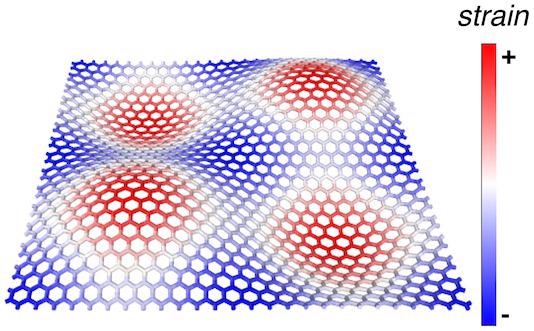Reviewed by Alex SmithJun 7 2022
Boris Yakobson, a materials theorist at Rice’s George R. Brown School of Engineering, and his colleagues believe that altering the contour of a layer of 2D material, and hence the interactions between its atoms, may be easier than previously imagined.
 A carefully contoured substrate can set up strain patterns in two-dimensional materials that affect their electronic and magnetic properties, according to a theoretical study at Rice University. These patterns could be used to explore quantum effects. Image Credit: Yakobson Research Group.
A carefully contoured substrate can set up strain patterns in two-dimensional materials that affect their electronic and magnetic properties, according to a theoretical study at Rice University. These patterns could be used to explore quantum effects. Image Credit: Yakobson Research Group.
While others twist 2D bilayers (two layers stacked together) of graphene and other materials to alter their topology, Rice researchers claim that expanding or stamping single-layer 2D materials on a cleverly engineered undulating surface will give them “unprecedented control” over their magnetic and electronic properties.
The study, researchers claim, paves the way for further research into many-body phenomena, or interactions between several microscopic particles, such as quantum systems.
Yakobson, with two of his lab’s alumni, Sunny Gupta and Henry Yu, co-lead authors, published a paper in Nature Communications.
Recent discoveries that suggested that twisting or otherwise deforming 2D materials bilayers like bilayer graphene into “magic angles” induced interesting electronic and magnetic phenomena, including superconductivity, was what inspired the researchers.
Instead of twisting, the researchers discovered that stamping, or growing a 2D material like hexagonal boron nitride (hBN) onto a bumpy surface naturally strains the material’s lattice, enabling it to form pseudo-electric and pseudo-magnetic fields and potentially display rich physical effects resembling twisted materials, according to their models.
The scientists determined that stressing the atoms in their model formed band structures, effectively turning hBN into a semiconductor.
The benefit of their technique, according to Gupta, is that the deformation through the surface bumps would be highly controllable, as substrates could be precisely shaped using electron-beam lithography.
This will also allow one to controllably change the electronic states and quantum effects by designing substrates with different topography.
Sunny Gupta, Study Co-Lead Author, Rice University
The path that the charge takes is a model for 1D systems since it can be regulated to flow in one direction. According to Yakobson, this can be utilized to investigate features of 1D quantum systems that are not accessible via twisted graphene.
Imagine a road with a single lane such that the cars are allowed to move in only one direction. A car cannot overtake the one in front, so traffic will move only when all cars move collectively.
Sunny Gupta, Study Co-Lead Author, Rice University
“This is not the case in 2D or when you have multiple lanes, where the cars—or electrons—can pass,” he added. “Like cars, electrons in a 1D system will flow collectively and not individually. This makes 1D systems special with rich, unexplored physics.”
According to Gupta, forming a rough substrate with an electron beam would be far easier than twisting 2D bilayers of graphene or other heterostructures like hBN to less than a single degree of precision, which is now the case.
Moreover, one can realize 1D quantum states, which are not typically accessible by twisting 2D bilayers. This will allow for the exploration of physical effects in 1D that has remained largely elusive until now.
Sunny Gupta, Study Co-Lead Author, Rice University
Yakobson is the Karl F. Hasselmann Professor of Engineering and a professor of materials science and nanoengineering and of chemistry.
The US Army Research Office (W911NF-16-1-0255) and the Office of Naval Research (N00014-18-1-2182) funded the study. The National Science Foundation’s XSEDE facility supplied computing resources.
Journal Reference:
Gupta, S., et al. (2022) Designing 1D correlated-electron states by non-Euclidean topography of 2D monolayers. Nature Communications. doi.org/10.1038/s41467-022-30818-2.